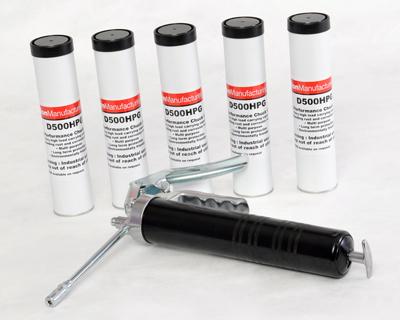
Dillon Chucks and Jaws introduces HPG500, a premium boundary lubricant that prevents metal-to-metal contact under high load and slow speed conditions for either high-end manual chucks or power chucks. This high-performance NLDI Grade 2, lubricating grease has exceptional mechanical stability, very high load carrying capacity, and excellent water and moisture resistance. It has a water washout rating of less than 3 percent, making it one of the most water resistant products available, according to the company. Plus, its unique formulation gives it outstanding rust and corrosion resistance, even in the presence of a synthetic and oil based coolant environment. This chuck lubricating grease handles high loads, and provides long term corrosion protection under the most hostile conditions.
The environmentally friendly formulation contains no heavy metals or other environmentally undesirable materials such as compounds containing antimony, barium, lead, chlorine, phenols, or phosphorus. This lithium-free formula does not react negatively when contacting the water contained in water based coolants – as opposed to lubricants with lithium which cause lithium build-up on the internal workings of the chuck.
An all-purpose industrial lubricant, HPG500 can be used in bearings, bushings, slides, pivots and tracks, which are important engineering components of manual and power chucks. It is recommended wherever high lubricity, EP (Extreme Pressure) properties, mechanical stability, rust and corrosion protection, water washout protection, and good oxidation stability are required.
Essential for the safe operation, and maintaining maximum gripping pressure of chucks, HPG500 is available in 14 oz. tubes. It can be purchased by the tube, in cases of 10 or 50 each. A greasing set, consisting of a grease gun, two tubes of grease and one grease adaptor fitting, is also available. HPG500 is also safe to use in machine centers that require EPI grease.
Contact Details
Related Glossary Terms
- centers
centers
Cone-shaped pins that support a workpiece by one or two ends during machining. The centers fit into holes drilled in the workpiece ends. Centers that turn with the workpiece are called “live” centers; those that do not are called “dead” centers.
- chuck
chuck
Workholding device that affixes to a mill, lathe or drill-press spindle. It holds a tool or workpiece by one end, allowing it to be rotated. May also be fitted to the machine table to hold a workpiece. Two or more adjustable jaws actually hold the tool or part. May be actuated manually, pneumatically, hydraulically or electrically. See collet.
- coolant
coolant
Fluid that reduces temperature buildup at the tool/workpiece interface during machining. Normally takes the form of a liquid such as soluble or chemical mixtures (semisynthetic, synthetic) but can be pressurized air or other gas. Because of water’s ability to absorb great quantities of heat, it is widely used as a coolant and vehicle for various cutting compounds, with the water-to-compound ratio varying with the machining task. See cutting fluid; semisynthetic cutting fluid; soluble-oil cutting fluid; synthetic cutting fluid.
- corrosion resistance
corrosion resistance
Ability of an alloy or material to withstand rust and corrosion. These are properties fostered by nickel and chromium in alloys such as stainless steel.
- extreme pressure additives ( EP)
extreme pressure additives ( EP)
Cutting-fluid additives (chlorine, sulfur or phosphorus compounds) that chemically react with the workpiece material to minimize chipwelding. Good for high-speed machining. See cutting fluid.
- lubricity
lubricity
Measure of the relative efficiency with which a cutting fluid or lubricant reduces friction between surfaces.

